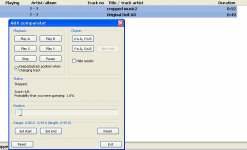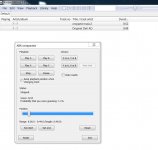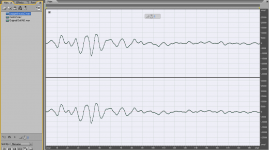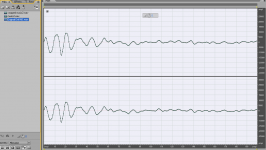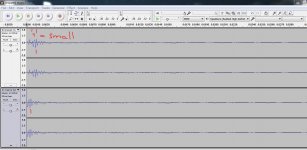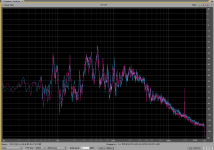Your AD DA
Karl,
I am sorry to say that, but your chain is not transparent enough. One of the files has much higher noise audible. My result is 6/6, I was lazy to listen more ...
The tracks have different length (Dell AD is shorter), so the ABX may be cheated. Anyway, I have listened only first seconds, and one of the file is noisier so it is quite easy to discern them, with transparent D/A and good headphone amplifier and good headphones.
Once again sorry, but so it goes.
Karl,
I am sorry to say that, but your chain is not transparent enough. One of the files has much higher noise audible. My result is 6/6, I was lazy to listen more ...
The tracks have different length (Dell AD is shorter), so the ABX may be cheated. Anyway, I have listened only first seconds, and one of the file is noisier so it is quite easy to discern them, with transparent D/A and good headphone amplifier and good headphones.
Once again sorry, but so it goes.
Attachments
Last edited:
Hi Karl,
would you mind me asking a question, the "cropped music 2.wav" is the same file as my "music2.wav"? I am asking for the reason they have different size in kB. Maybe I only did not understand your post correctly, please let me know.
Thanks, Pavel
P.S.: my ABX result in the next post.
Hi Pavel,
Yes, the file was cropped in Audacity to give a definite start point I could relate too.
Great ABX result... I might try again on that... its a bit quieter wind and weather wise today 🙂
Tried again at slightly higher volume.
Once you mentioned noise 🙂 I turned the volume up a little. Yes I hear it.
So the hardware is detectable on that basis.
How did the "fidelity" of the track come across to you ? Do you think it is good enough or at least useful to show the sonic differences in circuitry when the AD chain would be common to both samples ? For example one buffer circuit vs another.
Once you mentioned noise 🙂 I turned the volume up a little. Yes I hear it.
So the hardware is detectable on that basis.
How did the "fidelity" of the track come across to you ? Do you think it is good enough or at least useful to show the sonic differences in circuitry when the AD chain would be common to both samples ? For example one buffer circuit vs another.
Attachments
Karl, the file would deteriorate each time it goes through a conversion process, D>A and then A>D. Pavel's exact file can be the only master for the purpose. No editing, cutting, pasting, cropping or anything else done to it. The noise floor would lift with every process adding both jitter and conversion noise.
Hi Nico,
Yes I understand that very well 🙂 I was more interested in whether that degradation is an audible and a limiting factor in these tests.
In the Supertramp test it wasn't subjectively picked up that one file was direct and one recorded. A little subjective noise would not have shown on that track though. I suspect it would not on the Natalie Cole either... as far as I remember no one commented on it. What was commented on though was "harshness" in one part. Was that on the original, or a problem with the record process/CD player.
Both the Supertramp track and the Natalie Cole track were not highly favoured as suitable test pieces by some... you know how it goes 😀 you can't please all the people all the time 🙂
What I am trying to do in all these tests is to try and see what the limits are and to see what works best.
So moving on, Pavels track is a very well recorded example that has allowed the noise aspect to be picked out. How about the fidelity compared to the original though ? Does that compare well. Personally, I think it does. If the AD version was all you had heard could you fairly criticise it in its own right ? If yes then say why.
The ABX tests I have done here are as I mentioned... no runs and reruns, no special settings, no enabling equalisers to boost HF. Yesterday at lowish levels I couldn't pick them apart, today Pavel mentioned the noise, I turned the level up a little and yes, easily differentiated. If others want to try then that's great, its done relying on the honesty and integrity of those partaking.
Ultimately though I want to see and prove things to myself. Of course a film a cap is better than a handful of electros, everybody tells me it is 😀... but is it ? No one trying the test could tell at the time. So we come back round to the (maybe valid) argument that the gear used wasn't up to snuff.
That is what I am trying to determine.
Yes I understand that very well 🙂 I was more interested in whether that degradation is an audible and a limiting factor in these tests.
In the Supertramp test it wasn't subjectively picked up that one file was direct and one recorded. A little subjective noise would not have shown on that track though. I suspect it would not on the Natalie Cole either... as far as I remember no one commented on it. What was commented on though was "harshness" in one part. Was that on the original, or a problem with the record process/CD player.
Both the Supertramp track and the Natalie Cole track were not highly favoured as suitable test pieces by some... you know how it goes 😀 you can't please all the people all the time 🙂
What I am trying to do in all these tests is to try and see what the limits are and to see what works best.
So moving on, Pavels track is a very well recorded example that has allowed the noise aspect to be picked out. How about the fidelity compared to the original though ? Does that compare well. Personally, I think it does. If the AD version was all you had heard could you fairly criticise it in its own right ? If yes then say why.
The ABX tests I have done here are as I mentioned... no runs and reruns, no special settings, no enabling equalisers to boost HF. Yesterday at lowish levels I couldn't pick them apart, today Pavel mentioned the noise, I turned the level up a little and yes, easily differentiated. If others want to try then that's great, its done relying on the honesty and integrity of those partaking.
Ultimately though I want to see and prove things to myself. Of course a film a cap is better than a handful of electros, everybody tells me it is 😀... but is it ? No one trying the test could tell at the time. So we come back round to the (maybe valid) argument that the gear used wasn't up to snuff.
That is what I am trying to determine.
Thanks Pavel. One thing I have noticed is that aligning files in Audacity is not always easy and I seriously wonder if something like "noise" on the AD file accounts for a difference. Sometimes the first part of any identifiable audio on a track can look visibly "different". I have noticed that many times such that I sometimes take a screen shot showing the "cut" point. When I import the comparison file (that's been through the AD) it can appear slightly different at low amplitudes. Noise affecting sample point ?
OK 🙂 Lets try them in Audacity again and see the scale. I find with Audacity that when you drag the cursor to mark a section out and the time counter on the bottom changes to show the start and finish points, such that if you then manually input an end time to equal the time showing on the counter that the cursor jumps forward or back slightly. Maybe because manually dragging gives totally variable position but sometimes it doesn't align with sample points that are usable.
How close in practice do tracks need to be for a reliable ABX result ? Foobar (as I use it) does a sort of "soft mute" as you change from A to B, its not an unnoticed switch as such.
OK 🙂 Lets try them in Audacity again and see the scale. I find with Audacity that when you drag the cursor to mark a section out and the time counter on the bottom changes to show the start and finish points, such that if you then manually input an end time to equal the time showing on the counter that the cursor jumps forward or back slightly. Maybe because manually dragging gives totally variable position but sometimes it doesn't align with sample points that are usable.
How close in practice do tracks need to be for a reliable ABX result ? Foobar (as I use it) does a sort of "soft mute" as you change from A to B, its not an unnoticed switch as such.
Attachments
FYI, I have found similar HF spectral line, that you experienced in "Supertramp", in a brand new 96kHz/24bit data that are being sold by a renown recording company ....
The line is close to 19.700 Hz and it is probably an effect of studio "green" lights.
The line is close to 19.700 Hz and it is probably an effect of studio "green" lights.
Attachments
Karl, just ran them through on a cold system, and on the fidelity aspect they clearly differentiate, noise didn't come into for me.So the hardware is detectable on that basis.
How did the "fidelity" of the track come across to you ? Do you think it is good enough or at least useful to show the sonic differences in circuitry when the AD chain would be common to both samples ? For example one buffer circuit vs another.
What the Dell was doing was a slight 'averaging' of the sound, reducing the sparkle and apparent dynamic quality of individual sound elements - and, adding an edge on strong transient sounds: the intense pulling on the guitar strings at one point had an artificial, extra bite to it on the Dell. The little run on the piano close to the end of the track was a very strong marker - subjectively, it almost disappeared on the Dell, not because the sound wasn't there, but because tonally it blended in too much with the rest of the mix ...
What the Dell was doing was a slight 'averaging' of the sound, reducing the sparkle and apparent dynamic quality of individual sound elements - and, adding an edge on strong transient sounds
= noise + distortion.
In Audacity, if one is willing to spend a little bit of effort one get get 'perfect' alignment on some aspect, I've done this on other occasions, when I was looking at what DiffMaker couldn't handle, 😀. Quite often I used a process of upsampling to a high enough rate on both samples, until I could achieve precise alignment on a certain bit.Thanks Pavel. One thing I have noticed is that aligning files in Audacity is not always easy and I seriously wonder if something like "noise" on the AD file accounts for a difference.
The two files that Karl has posted are misaligned in 27 samples, zoom and cut is all one has to do.
When the playback and record are using different clocks then more usually needs to be done - and of course alignment is usually only possible over a relatively short period because of drift - DiffMaker is hopeless at handling this.
I was more interested in whether that degradation is an audible and a limiting factor in these tests.
What was commented on though was "harshness" in one part. Was that on the original, or a problem with the record process/CD player.
If we believe that caps sound different, sampling rates sound different, jitters sound different and so on and so on, can you imagine how much subjective quality we can have in a single CD Player?
That's why instead of by listening I prefer to see schematic if I buy such device, because I know that it can be tweaked or modified to sound to its best. The limit is the schematic and the chips. It takes experienced ears to know the potential of a device instead of simply looking at the schematics. Many can recognize 1-bit DAC for example. And if you have it, you don't have upgrade potential. Different if you have good circuits and good chips. Once you tweak a CDP to its potential, ime, you will be handicapped by the chip performance, which I believe is the SNR (or DNR) for a DAC chip.
Check the Micromega, does it have cap in signal path? Does it have 78XX/79XX regulator chips? Shared supply between digital and analog?
Of course a film a cap is better than a handful of electros, everybody tells me it is 😀... but is it ? No one trying the test could tell at the time. So we come back round to the (maybe valid) argument that the gear used wasn't up to snuff.
I have mentioned before joining the test that there is possibility that a string of 5 electrolytics sound better than cheap film cap. And it was proven. Tony prefers the cap string because of the "reverb" effect and I agree with that. And even tho I have never heard such cap string in life, I guessed correctly which was which. I mentioned that I could have (like Tony) preferred the cap string if not from experience I knew that such sound lead to fatigue (so I chosen film cap).
I don't understand why the gear should be considered not good enough. (1) The speaker and its synergy issue with amp is still the weaker link people have. Or may be the ears? (2) I cannot see the relative sound quality to be up side down. If you listen directly without ADC processing, I believe the relative quality will be the same (and as expected).
FYI, I have found similar HF spectral line, that you experienced in "Supertramp", in a brand new 96kHz/24bit data that are being sold by a renown recording company ....
The line is close to 19.700 Hz and it is probably an effect of studio "green" lights.
That is strange isn't it, particularly these days when its a studios "day job" to turn out impeccable recordings. They need some audiophiles on the team 😀
The two files that Karl has posted are misaligned in 27 samples, zoom and cut is all one has to do.
Honestly... something happens when I try and do this. For example, the Lidl portable and original rip looked nothing like each other at the start of the track. I even thought the Lidl was phase inverting it was so very different. For what its worth I usually click the zoom eight times at the start of the track to expand things.
I shall try harder next time and post screen shots of when it doesn't work.
Check the Micromega, does it have cap in signal path? Does it have 78XX/79XX regulator chips? Shared supply between digital and analog?
There are no series coupled caps in the audio path in the Micromega and it has at least 13 regulated rails. I think they are 78/79 type regs but all are extensively and correctly decoupled and all are placed physically on the PCB exactly where needed. For example each opamp has its own set of regs next to the device. The PCB is double sided with extensive grounding.
I have mentioned before joining the test that there is possibility that a string of 5 electrolytics sound better than cheap film cap. And it was proven. Tony prefers the cap string because of the "reverb" effect and I agree with that. And even tho I have never heard such cap string in life, I guessed correctly which was which. I mentioned that I could have (like Tony) preferred the cap string if not from experience I knew that such sound lead to fatigue (so I chosen film cap).
No. In the cap vs film test you used your undoubted skills as a "computer guy" to crack the key by looking for tell tale signatures in the twelve files and two reference tracks. You are a talented guy to be able to do that, but its not what the tests were about.
You only joined these later tests after the results and methodology were made public. You were able to listen to the track at first, you even said it was a "good one for tube lovers" if I remember correctly... then when you suspected something different was going on test wise you suddenly were unable to play the files asking was the download faulty or was something else needed to play them.
It's easy enough in Audacity to zoom to the point of being able to precisely select a single sample. To get the tracks to align I normally zoom in on a part of the track where there is high level, high frequency material, where it's easy to see how many samples are in the misalignment. Then just chop off that number of samples from the beginning of the appropriate track.
It's easy enough in Audacity to zoom to the point of being able to precisely select a single sample. To get the tracks to align I normally zoom in on a part of the track where there is high level, high frequency material, where it's easy to see how many samples are in the misalignment. Then just chop off that number of samples from the beginning of the appropriate track.
🙂 I find it not quite that easy tbh... often because the two files look "different" and Audacity changes the "cut point" when it actually executes the action.
Next time I'll pots screen shots and try detail and replicate what happens.
Maybe its just me 😀 but if I detail and show it then you can tell me where I'm going wrong.
No. In the cap vs film test you used your undoubted skills as a "computer guy" to crack the key by looking for tell tale signatures in the twelve files and two reference tracks. You are a talented guy to be able to do that, but its not what the tests were about.
If I cheated in the cap vs film cap, then I cheated also in all the other tests, because I have the skill to write a software to do just that 😀
You only joined these later tests after the results and methodology were made public. You were able to listen to the track at first, you even said it was a "good one for tube lovers" if I remember correctly... then when you suspected something different was going on test wise you suddenly were unable to play the files asking was the download faulty or was something else needed to play them.
If you can remember more, you will know what happened when I listened the music "streaming" using iPod and the bloody QuickTime. Internet connection is horrible for streaming in this part of the world. You know that "Reloading..." messages and file skipping and disconnecting. (I also mentioned several times that the iPod cannot be used to download such files, need iTunes).
Downloads have always been done with computer (at work) or Samsung android/handphone (at home). But the Samsung failed to play this file (also Pavel's high quality WAV files).
Because you asked to post my result so I thought, "well why not doing it streaming even tho with intermittent sound", so after reading your request I went to my listening room and play the file through my iPod using my reference speaker (previously it was using iPod internal speaker).
So when I came back to DIYAudio with a note on my hand (complete with track/time where the sound changes and complete with my perception of the sounds), I saw you already posted the answer. So my options were to post my result or not. So what rationale did I have to post it (beside it's already done)?
First, the most important reason was because I thought my post would help others to understand things (such as more difficult passage on part4). Second, there was unique result, where I made mistake preferring Micromega (part2) and at the same time thinking it was the worst (part4). But I was not the only one who made that mistake. But strangely the two others who made the same mistake thought that part4 is the better one (I think 5th Elements said "more oomph").
So it is not worth it to post it? For me, I still don't understand how a good player can sound like sheet (I didn't know how good the player was until you mention the chips used, and just now when you mentioned double-layered PCB, wow, must be expensive, BUT).
There are no series coupled caps in the audio path in the Micromega and it has at least 13 regulated rails. I think they are 78/79 type regs but all are extensively and correctly decoupled and all are placed physically on the PCB exactly where needed.
BUT I can mention here (for many times) that 78/79 sound like sheet. I don't need to write software to know that. I used my ears. That's for people to learn, doesn't really matter if they think it is just my illusion or that I'm cheating. There always be people who will believe or learn. That's why I'm posting the result, and more.
That is strange isn't it, particularly these days when its a studios "day job" to turn out impeccable recordings. They need some audiophiles on the team 😀
Honestly... something happens when I try and do this. For example, the Lidl portable and original rip looked nothing like each other at the start of the track. I even thought the Lidl was phase inverting it was so very different. For what its worth I usually click the zoom eight times at the start of the track to expand things.
I shall try harder next time and post screen shots of when it doesn't work.
It gets worse. To align start I cropped 26 samples from start of "cropped music2". Moving along in files it doesn't take long for offset to reappear. Original Dell starts leading. Lead continues to grow, the further along into tracks observation is made. By end of Original Dell, it leads by roughly 71-72 samples. This is due to either samples being dropped, or the D/A and A/D converters running different clocks.
- Status
- Not open for further replies.
- Home
- General Interest
- Everything Else
- Component audibility. Fact or fiction ?
